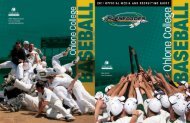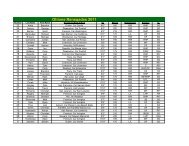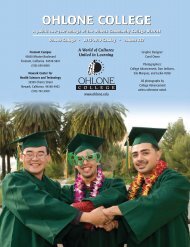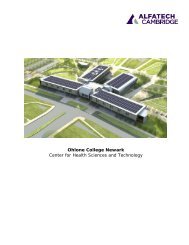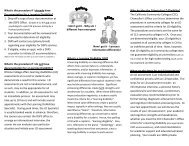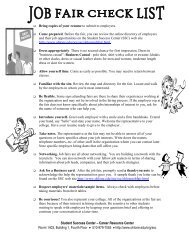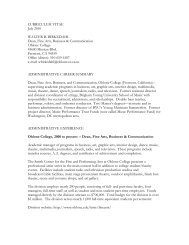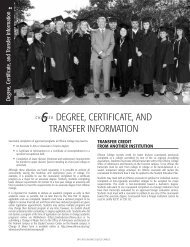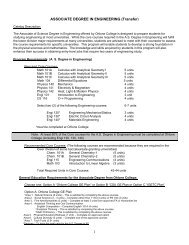2012-2013 Catalog (all pages) - Ohlone College
2012-2013 Catalog (all pages) - Ohlone College
2012-2013 Catalog (all pages) - Ohlone College
Create successful ePaper yourself
Turn your PDF publications into a flip-book with our unique Google optimized e-Paper software.
106 7 CURRICULUM GUIDES<br />
COMPUTER APPLICATIONS<br />
IN BIOTECHNOLOGY<br />
The field of computer applications in biotechnology is a complex hybrid of two<br />
distinct scientific disciplines—computer technology and bioscience. This<br />
certificate is designed to provide an understanding of bioinformatics and other<br />
computer related subjects to students with some computer and/or life science<br />
background. This program is useful for students who desire to explore this new<br />
information science in which computers help to simulate, visualize, and analyze<br />
genetic and biological information. It also provides an introduction to the<br />
fundamental scientific and computational concepts, methods, and tools central<br />
to the growing field of computer applications in biotechnology.<br />
STUDENT LEARNING OUTCOMES<br />
1. Examine cutting-edge biological concepts and computer technologies in<br />
biotechnology.<br />
2. Operate main databases, tools, and methods for the storage, searching, and<br />
analysis of biological molecules.<br />
3. Solve computational problems common to bioinformatics and apply<br />
classical computer science solutions to biotechnology.<br />
4. Use statistical analysis software systems for data analysis.<br />
5. Describe basic fundamentals of cells, major cellular components, DNA, and<br />
proteins.<br />
6. Apply fundamental algorithms in biomolecular sequence analysis to<br />
problem solving in biotechnology.<br />
BIOT-112 Introduction to Bioinformatics 2<br />
BIOT-121 Biotechnology Careers 1<br />
CS-131 Computing Concepts in Biotechnology 4<br />
CS-133 Introduction to SAS Programming 3<br />
BIOT-141B/CS-141B SAS Graphing and ODS OR 2<br />
BIOT-143/CS-143 Advanced SAS Programming OR (3)<br />
BIOT-133/CS-133A Data Analysis Using SAS (3)<br />
12-13<br />
COMPUTER PROGRAMMING<br />
Upon completion of the Computer Programming certificate program students<br />
will be capable of writing high-level language programs in procedural, objectoriented,<br />
and event-driven languages.<br />
STUDENT LEARNING OUTCOMES<br />
1. Given a specification, design an algorithm and implement the pseudocode<br />
to solve the problem.<br />
2. Given a program with logic errors, correct the code by applying debugging<br />
and data validation skills.<br />
CS-102 Introduction to Computer Programming Using C++ 4<br />
CS-104A Introduction to .NET Programming 4<br />
CS-116 Object-Oriented Programming Using C++ OR 4<br />
CS-170 Java Programming (4)<br />
CS-118 Introduction to Assembly Language Programming OR 4<br />
CS-124 Programming With Data Structures OR (4)<br />
CS-178 XML (3)<br />
15-16<br />
COSTUMING<br />
This certificate signifies that students have mastered the basic skills of costume<br />
construction and maintenance as well as the use of theatrical make-up.<br />
Successful completion will provide a solid basis for future study in costume<br />
design.<br />
STUDENT LEARNING OUTCOMES<br />
1. Show a basic understanding of hand stitching, sewing machine stitching<br />
techniques, draping, cutting, and the construction process typical for the<br />
costume construction industry.<br />
2. Apply the basic techniques of theatrical make-up using the appropriate<br />
materials and safety procedures.<br />
3. Demonstrate an understanding of how costumes affect the over<strong>all</strong> theatrical<br />
experience as it applies to performance.<br />
ART-106A Descriptive Drawing 3<br />
ID-158 Textiles 3<br />
TD-154 Theatrical Makeup for Stage, TV, and Dance 2<br />
TD-155A Costume Construction I 3<br />
TD-155B Costume Construction II 3<br />
TD-160A Production Lab OR .5<br />
TD-160A2 Production Lab (2)<br />
14.5-16<br />
DATA COMMUNICATIONS<br />
AND WEB PROGRAMMING<br />
This certificate will provide students with information and skills in data<br />
communications and Internet programming.<br />
STUDENT LEARNING OUTCOMES<br />
1. Develop skills in data communications and Internet programming.<br />
CAOT-153 Introduction to Internet 1<br />
CS-152 Data Communications 2<br />
CS-175 From JavaScript to AJAX 4<br />
7<br />
DATABASE ADMINISTRATION<br />
Database Administration certification combines training, experience, and testing<br />
to ensure that students have a strong foundation and expertise in the industry’s<br />
most advanced database management system.<br />
STUDENT LEARNING OUTCOMES<br />
1. Configure an Oracle database for multilingual applications, use various<br />
methods of recovering and tuning the database, and use database<br />
technologies such as Resource Manager, Scheduler, and Automatic Storage<br />
Management (ASM).<br />
2. Demonstrate appreciation of the ICT career field and the need to be lifelong<br />
learners.<br />
CNET-135 Database Fundamentals I:<br />
Database Architecture and Administration 2<br />
CNET-136 Database Fundamentals II:<br />
Database Backup and Recovery 2<br />
CNET-137 Introduction to SQL 4<br />
CNET-138 PL/SQL Programming 4<br />
12<br />
<strong>2012</strong>-<strong>2013</strong> OHLONE COLLEGE CATALOG





